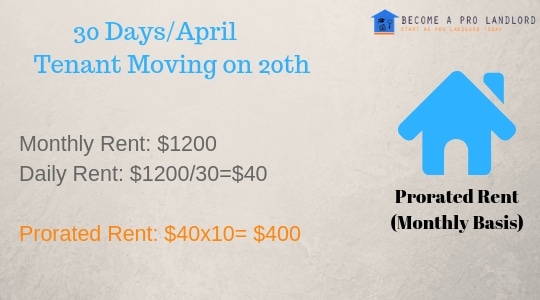Prorated Rent- How To Calculate? (Simplified For Landlords)
On several occasions, landlords are required to prorate the rent. And, not having the right information about prorated rent; you can stuck in tricky situations. Though, prorating rent is not as difficult as it seems to some landlords. Calculating prorated rent is easy and there are various ways of doing it.
Prorated Rent means when a tenant pays only for the number of days, he or she has occupied the rental. You prorate the rent when move-in or the move-out date is on a day other than the beginning or the end of the month. Proration allows the tenant to pay only the proportional rent and not the full month of rent. Also, it is out of the landlord`s will to prorate or not depending on your state laws.
What is Prorated Rent?
Prorated Rent simply means adjusting the rents when the tenant is not occupying the rental unit for a full complete month. In such a case, the tenant would wish to avoid paying for a full month and as a landlord, you may need to adjust the rents and charge only for those days the rental was occupied. To calculate prorated rent, simply break the total monthly cost of occupying the rental into daily per day cost.
How to Calculate Prorated Rent?
There are two ways you can calculate the prorated rent for your tenant. The proration can be done either on a month-to-month basis or on yearly basis.
a) How To Calculate Prorated Rent on Monthly Basis?

Most tenants prefer landlords to prorate the rent based on a monthly basis. But when you apply this method, tenants may question whether are you prorating rent based on 30 or 31 days? Or for that matter, how to prorate rent when the tenant moves in or moves out in the month of February, which has 28 days or 29 days based on a leap year?
The simple answer to this problem is to find out per day rent based on the number of days in the month. No matter if the month has 30 days or 31 days, divide the monthly rent by the number of days in that month. Even if the month has 28 days or 29 days in February, the formula remains the same.
→Daily Rent= Monthly Rent/No. of Days in month
→Prorated Rent= No. of Days tenant staying at Property X Daily Rent
So, the complete formula to calculate prorated rent on monthly basis goes as
Prorated Rent= No. of Days tenant staying at the Property X (Monthly Rent / No. of Days in a month)
b) How To Calculate Prorated Rent on Yearly Basis?

Calculating the prorated rent on a calendar year basis is the most suitable method as it eliminates any confusion between you and your tenant.
→Prorated Rent= No. of Days tenant staying at Property X Daily Rent
→Daily Rent= (Monthly Rent X 12) / No. of days in a year
So, the complete formula goes as
Prorated Rent= No. of Days tenant staying at Property X {(Monthly Rent X 12) / No. of days in a year}
However, some tenants consider a monthly basis proration easy and wish to calculate accordingly. They don`t see a bigger picture and feel comfortable with month-based prorated rent. On a yearly basis, they feel you are accounting for the time period, they don’t stay at the property especially if they stayed for just a few months. Although, for a year-long lease agreement, prorating the rent based on the yearly method is best suited.
A Year based prorated rent always comes less compared to when prorated on monthly basis.
Do Landlords need to Prorate the Rent?
Prorating rent for the tenant is out of the will of the landlord. You necessarily need not prorate rent always. There is no law that demands you to prorate the rent.
This case is valid for both move-in and move-out of a tenant. Even when a tenant moves out a few days before the end of the lease, you are not required to prorate the rent. You can charge the complete month of rent. It totally depends upon your will. The only legal possibility when you need to prorate the rent is when the tenant has served a proper notice to vacate.
However, in some states, prorating rent may be required by the law. So, it is always advisable to check the laws of your state before renting to a tenant.
When Should You Prorate the Rent?
Prorating the rent is in favor of both the landlord and the tenant. Both parties get benefits if you allow your tenant to pay rent on a prorated basis. A landlord enjoys these benefits.

- Fill Vacancies Faster:
Suppose you have a rental unit that is vacant. Now a prospect comes and shows interest in your property. He wants to occupy it from the 20th of this month and you are standing on 15th. You know there is less scope of a tenant turnover before the next month. You can then easily take this opportunity to rent your property by prorating the rent and having this tenant move into your property.
But if you don’t consider prorating the rent, you will either ask the tenant to pay for this full month’s rent or come on 1st the next month. In any case, the chances of losing the tenant are high. However, if you accept prorated rent; you are not only filling the vacancy but also collecting the rent for the period that might go vacant.
- Nurturing Landlord-Tenant Relationship:
Your tenant will definitely appreciate you for prorating the rent. Finding a helpful landlord, your tenant will likely stay more at your property. You are being flexible for your tenant with his move-in schedule.
This is a good gesture for the tenant by his landlord. It further helps the landlord to build a positive relationship with the tenant. And there is no denying the fact how important it is to have a good relationship with your customers in business.
- Convenience
Prorating the rent, you can keep your rent collection dates the same. Most landlords collect the rent on the 1st of every month. By prorating rent, you can collect on every 1st no matter when the tenant moves into your property. You need not trouble yourself for collecting rent on different dates. Simply, prorate the rent from the date the tenant has moved in at your property to the 1st of the next month.
Most times, landlords allow their tenants to keep the rent for the extra days if they are moving out 1-2 days late after the end of the month for convenience. Who will like the trouble of keeping the records for those extra days? But, if you know how to prorate rent; you can easily charge the extra rent without losing a single dime of your money.
Also Read: 23 Brilliant Hacks To Make More Money From your Rental Unit
How to Prorate Utilities?
Not just the rent; sometimes landlords are also required to prorate the utilities for tenants. You can use the above same formula to prorate utilities as well.
It makes sense for the tenant to also get the cost of utilities prorated along with rent. If you are charging a tenant for utilities like water, sewerage, and garbage collection on a monthly or yearly basis, you can simply prorate it for your tenant.
Some utilities like electricity and gas cannot be prorated as they are charged only when the tenant uses them. So, be cautious while prorating utilities for your tenant. Only prorate those utilities which are charged on a monthly or yearly basis. And, not those utilities that are charged on a consumption basis.
→Prorated Rent (Month Wise) = No. of Days tenant staying at Property X (Monthly Rent + Utilities/No. of Days in a month)
→Prorated Rent (Year Wise) = No. of Days tenant staying at Property X {(Monthly Rent + Utilities X 12)/ No. of days in a year}
How to Draft A Prorated Lease Agreement?

Drafting the lease becomes tricky when you are prorating the rent. A sense of confusion can arise about the start date of the lease agreement and the end date of the lease agreement. Whether should you start the lease from the date the tenant is moving in or from the 1st of next month?
You should always start the lease from the date, the tenant is moving in. By doing this you are making the tenant comply with the terms and conditions listed in the lease from day one. So, the start date will be on the same date the tenant is moving in and keep the due date of rent to the 1st of every month.
Suppose the tenant is moving on the 20th of April. Then, start the lease from 20th April and, end it on 30th April the next year if it’s a yearlong lease. The Due date for rent will be the 1st of every month. But, now the question arises. When should you collect the prorated rent?
How to Collect Prorated Rent During Moving In?

Collecting Prorated Rent during the time when the tenant is moving in can create confusion. Landlords prefer to collect the prorated rent during the time the tenant signs the lease agreement. You are technically collecting the security deposit, one month of rent, and the prorated rent altogether from the tenant. This sure is to create confusion, and the tenant may find this way of collection inappropriate. The tenant is already paying the full month of rent and the security deposit. Paying additional prorated rent during this time makes no sense for the tenant.
Ever Wondered: What if the security deposit is not enough to cover damages?
So, the best way is to collect the prorated rent is when it actually becomes due. Suppose your tenant is moving on the 20th of the month and paying you the security deposit and full month of rent. Then, collect the prorated rent from this tenant when it actually becomes due, that is, on the 20th of next month. No scope for confusion whatsoever.
In the event, that the term of the tenancy agreement commences on any day other than the first day of the month the Tenant shall pay prorated rent which shall be obtained by multiplying the monthly rent by a factor of 1/30 by the number of days from the day, the agreement commences to the end of the month. On execution of this agreement/ on or before ____, the tenant will pay the landlord $__________ as prorated rent.
When you and your tenant have mutually agreed to rent proration. It is best that you include the above-mentioned prorated rent clause in the lease agreement. This will eliminate any confusion and your tenant will be well informed in advance when the date is actually due to pay the prorated rent.
The Bottom Line
Prorating rent is simple and does not involve any rocket science to crack the code. Being a landlord, you should be open about prorating the rent. It gives you an edge in operating as a successful landlord. If you still occur to any questions and find a problem prorating the rent, let us know in the comment section below.
Find this article helpful? Then you may want to subscribe to our weekly newsletter. We are empowering landlords to become better landlords and manage their property rental business more effectively. Also, you can be a part of our community on Facebook.


